Aviation Meteorology at Several Plane Crash Sites
Abstract
:1. Introduction
2. The Objects of This Research
3. Measurements, Datasets and Methods
4. Analysis of Model Simulations
4.1. The Sea Breeze Front (SBF) Crash Events
4.2. The Mountain Wave Turbulent (MWT) Crash Study Case
5. Conclusions
Funding
Acknowledgments
Conflicts of Interest
Abbreviations and Acronyms
| AVHRR | Advanced Very High Resolution Radiometer SST dataset |
| CIBL | Convective Internal Boundary Layer |
| FNL | Final meteorological dataset of Operational Model Global Tropospheric Analyses, NCAR/NCEP, USA |
| GFS | Global Forecast System meteorological dataset, NCAR/NCEP, USA |
| HCR | Horizontal Convective Rolls |
| Il | Ilyushin |
| KHBs | Kelvin-Helmholtz Billows |
| NCAR | National Centre for Atmospheric Research, USA |
| NCEP | National Centres for Environmental Prediction, USA |
| NOAA | National Oceanic and Atmospheric Administration, U.S. Department of Commerce |
| PBL | Planetary Boundary Level |
| QKE | twice turbulent Kinetic Energy |
| RTG-HR | Real-Time Global High-Resolution SST dataset |
| SBC | Sea Breeze Circulation |
| SBF | Sea Breeze Front |
| SBG | Sea Breeze Gravity current |
| SBH | Sea Breeze Head |
| SLF | Sea-Land Front in SBC |
| SST | Sea Surface Temperature |
| TKE | Turbulent Kinetic Energy |
| Tu | Tupolev |
| WRF-ARW | (Weather Research and Forecasting)-(Advanced Research WRF) model |
| w | vertical component of wind speed |
| w-Front | upward front of z-component of wind speed, w > 0 |
References
- Orlanski, I. A rational subdivision of scales for atmospheric processes. Bull. Am. Meteorol. Soc. 1975, 56, 527–530. [Google Scholar]
- Ray, P.S. Mesoscale Meteorology and Forecasting; American Meteorological Society: Boston, MA, USA, 1986; p. 793. [Google Scholar]
- Holton, J. An Introduction to Dynamic Meteorology; Academic Press: San Diego, CA, USA, 1992; p. 511. [Google Scholar]
- Shin, H.H.; Hong, S.-Y. Free Access Representation of the Subgrid-Scale Turbulent Transport in Convective Boundary Layers at Grey-Zone Resolutions. Mon. Weather Rev. 2015, 143, 250–271. [Google Scholar] [CrossRef]
- Tomassini, L.; Field, P.R.; Honnert, R.; Malardel, S.; McTaggart-Cowan, R.; Saitou, K.; Noda, A.T.; Seifert, A. The “Grey Zone” cold air outbreak global model intercomparison: A cross evaluation using large-eddy simulations. J. Adv. Model. Earth Syst. 2017, 9. [Google Scholar] [CrossRef]
- Wong, W.-K.; Lau, C.-S.; Chan, P.-W. Prediction System for Aviation Applications at the Hong Kong International Airport. Adv. Meteorol. 2013, 11. [Google Scholar] [CrossRef]
- Kizhner, L.I.; Barashkova, N.K.; Akhmetshina, A.S.; Bart, A.A.; Starchenko, A.V. Forecast of Precipitation in the Area of Bogashevo Airport Using the WRF Model. Atmos. Ocean. Opt. 2014, 27, 187–194. [Google Scholar] [CrossRef]
- Chan, P.W.; Wong, W.K. An Analysis of a Severe Turbulence Event Encountered by an Aircraft over the South China Sea and the Application of Numerical Weather Prediction Models in the Early Alerting. Adv. Meteorol. 2014, 11. [Google Scholar] [CrossRef]
- Chen, G.; Zhu, X.; Sha, W.; Iwasaki, T. Toward Improved Forecasts of Sea-Breeze Horizontal Convective Rolls at Super High Resolutions. Part I: Configuration and Verification of a Down-Scaling Simulation System (DS3). Mon. Weather Rev. 2015, 143. [Google Scholar] [CrossRef]
- Herman, G.R.; Schumacher, R.S. Using Reforecasts to Improve Forecasting of Fog and Visibility for Aviation. Weather Forecast. 2016, 31, 467–482. [Google Scholar] [CrossRef]
- Chaouch, N.; Temimi, M.; Weston, M.; Ghedira, H. Sensitivity of the meteorological model WRF-ARW to planetary boundary layer schemes during fog conditions in a coastal arid region. Atmos. Res. 2017, 187, 106–127. [Google Scholar] [CrossRef]
- Antonelli, M.; Rotunno, R. Large-Eddy Simulation of the Onset of the Sea Breeze. J. Atmos. Sci. 2007, 64, 4445–4457. [Google Scholar] [CrossRef]
- Rizza, U.; Miglietta, M.M.; Anabor, V.; Degrazia, G.A.; Maldaner, S. Large-eddy simulation of sea breeze at an idealized peninsular site. J. Mar. Syst. 2015, 148, 167–182. [Google Scholar] [CrossRef]
- Calmet, I.; Mestayer, P.G.; van Eijk, A.M.J.; Herlédant, O. A Coastal Bay Summer Breeze Study, Part 2: High-resolution Numerical Simulation of Sea-breeze Local Influences. Bound.-Layer Meteorol. 2017. [Google Scholar] [CrossRef]
- SOCHI Airport Information, Details for Sochi Adler (URSS). 25 May 2015. (On Russian and English Language). Available online: http://vau.aero/navdb/chart/URSS.pdf (accessed on 25 January 2019).
- BEA FINAL REPORT on the Investigation into the Accident Involving the Armavia A320 Near Sochi Airport on 3 May 2006. Available online: https://www.bea.aero/docspa/2006/ek-9060502/pdf/ek-9060502.pdf (accessed on 25 January 2019).
- LFMP Airport Information, Details for Perpignan Rivesaltes Airport (LFMP). Available online: http://vau.aero/navdb/chart/LFMP.pdf (accessed on 25 January 2019).
- BEA Bureau d’Enquêtes et d’Analyses pour la sécurité de l’aviation civile. Accident on 27 November 2008 off the Coast of Canet-Plage (66) to the Airbus A320-232 registered D-AXLA Operated by XL Airways Germany. September 2010. Available online: https://www.bea.aero/docspa/2008/d-la081127.en/pdf/d-la081127.en.pdf (accessed on 25 January 2019).
- BEA COMMISSION D’ENQUETE. Rapport Final sur l’Accident Survenu le 29 Juin 2009 En mer au large de Moroni (Comores) De l’Airbus A310-324 Immatriculé 7O-ADJ Exploité par la compagnie Yemenia Airways. Available online: https://www.bea.aero/docspa/2009/7o-j090629/pdf/7o-j090629.pdf (accessed on 25 January 2019).
- Skamarock, W.C.; Klemp, J.B.; Dudhia, J.; Gill, D.O.; Barker, D.; Duda, M.G.; Huang, X.-Y.; Wang, W. A Description of the Advanced Research WRF Version 3. NCAR Tech. Note NCAR/TN-475+STR 2008. [Google Scholar] [CrossRef]
- NCEP FNL DS083.2 Meteorological Fields, National Centers for Environmental Prediction/National Weather Service/NOAA/U.S. Department of Commerce. NCEP FNL Operational Model Global Tropospheric Analyses, Continuing from July 1999. Research Data Archive at the National Centre for Atmospheric Research, Computational and Information Systems Laboratory. 2000. Available online: https://rda.ucar.edu/datasets/ds083.2/ (accessed on 25 January 2019).
- Reynolds, R.W.; Chelton, D.B. Comparisons of daily sea surface temperature analyses for 2007–2008. J. Clim. 2010, 23, 3545–3562. [Google Scholar] [CrossRef]
- Grell, G.A.; Devenyi, D. A generalized approach to parameterizing convection combining ensemble and data assimilation techniques. Geophys. Res. Lett. 2002, 29. [Google Scholar] [CrossRef]
- Jiménez, P.A.; Dudhia, J.; González-Rouco, J.F.; Navarro, J.; Montávez, J.P.; García-Bustamante, E. A Revised Scheme for the WRF Surface Layer Formulation. Mon. Weather Rev. 2012, 140, 898–918. [Google Scholar] [CrossRef] [Green Version]
- Nakanishi, M.; Niino, H. An Improved Mellor-Yamada Level 3 Model: Its Numerical Stability and Application to a Regional Prediction of Advection Fog. Bound.-Layer Meteorol. 2006, 119, 397–407. [Google Scholar] [CrossRef]
- Pleim, J.E.; Xiu, A. Development and Testing of a Surface Flux and Planetary Boundary Layer Model for Application in Mesoscale Models. J. Appl. Meteorol. 1995, 34, 16–32. [Google Scholar] [CrossRef] [Green Version]
- Xiu, A.; Pleim, J.E. Development of a Land Surface Model. Part I: Application in a Mesoscale Meteorological Model. J. Appl. Meteorol. 2001, 40, 192–209. [Google Scholar] [CrossRef]
- Dudhia, J. Numerical Study of Convection Observed during the Winter Monsoon Experiment Using a Mesoscale Two-Dimensional Model. J. Atmos. Sci. 1989, 46, 3077–3107. [Google Scholar] [CrossRef] [Green Version]
- Mlawer, E.J.; Taubman, S.J.; Brown, P.D.; Iacono, M.J.; Clough, S.A. Radiative transfer for inhomogeneous atmospheres: RRTM, a validated correlated-k model for the longwave. J. Geophys. Res. 1997, 102, 16663–16682. [Google Scholar] [CrossRef] [Green Version]
- Lim, K.-S.S.; Hong, S.-Y. Development of an Effective Double-Moment Cloud Microphysics Scheme with Prognostic Cloud Condensation Nuclei (CCN) for Weather and Climate Models. Mon. Weather Rev. 2010, 138, 1587–1612. [Google Scholar] [CrossRef]
- Wicker, L.J.; Skamarock, W.C. Time-splitting methods for elastic models using forward time schemes. Mon. Weather Rev. 2002, 130, 2088–2097. [Google Scholar] [CrossRef]
- Smagorinsky, J. General circulation experiments with the primitive equations: 1. The basic experiment. Mon. Weather Rev. 1963, 91, 99–164. [Google Scholar] [CrossRef]
- Abbs, D.J.; Physick, W.L. Sea-breeze observations and modelling: A review. Aust. Meteorol. Mag. 1992, 41, 7–19. [Google Scholar]
- Miller, S.T.K.; Keim, B.D.; Talbot, R.W.; Mao, H. Sea breeze: Structure, forecasting and impacts. Rev. Geophys. 2003, 41, 1011. [Google Scholar] [CrossRef]
- Crosman, E.T.; Horel, J.D. Sea and Lake Breezes: A Review of Numerical Studies. Bound.-Layer Meteorol. 2010, 137, 1–29. [Google Scholar] [CrossRef] [Green Version]
- Dailey, P.S.; Fovell, R.G. Numerical Simulation of the Interaction between the Sea-Breeze Front and Horizontal Convective Rolls. Part I: Offshore Ambient Flow. Mon. Weather Rev. 1999, 127, 858–878. [Google Scholar] [CrossRef]
- Helmis, C.G.; Asimakopoulos, D.N.; Deligiorgi, D.G.; Lalas, D.P. Observations of sea-breeze fronts near the shoreline. Bound.-Layer Meteorol. 1987, 38, 395. [Google Scholar] [CrossRef]
- Chiba, O. The turbulent characteristics in the lowest part of the sea breeze front in the atmospheric surface layer. Bound.-Layer Meteorol. 1993, 65, 181–195. [Google Scholar] [CrossRef]
- Stephan, K.; Kraus, H.; Ewenz, C.M.; Hacker, J.M. Sea-breeze front variations in space and time. Meteorol. Atmos. Phys. 1999, 70, 81–95. [Google Scholar] [CrossRef]
- Arrillaga, J.A.; Yagüe, C.; Sastre, M.; Román-Cascón, C. A characterisation of sea-breeze events in the eastern Cantabrian coast (Spain) from observational data and WRF simulations. Atmos. Res. 2016, 181, 265–280. [Google Scholar] [CrossRef]
- Steele, C.J.; Dorling, S.R.; von Glasow, R.; Bacon, J. Idealized WRF model sensitivity simulations of sea breeze types and their effects on offshore windfields. Atmos. Chem. Phys. 2013, 13, 443–461. [Google Scholar] [CrossRef] [Green Version]
- Li, Y.K.; Chao, J.P. An Analytical Solution for Three-Dimensional Sea–Land Breeze. J. Atmos. Sci. 2016, 73, 41–53. [Google Scholar] [CrossRef]
- Wingrove, R.C.; Bach, R.E., Jr. Severe Turbulence and Maneuvering from Airline Flight Records. J. Aircr. 1994, 31, 753–760. [Google Scholar] [CrossRef]
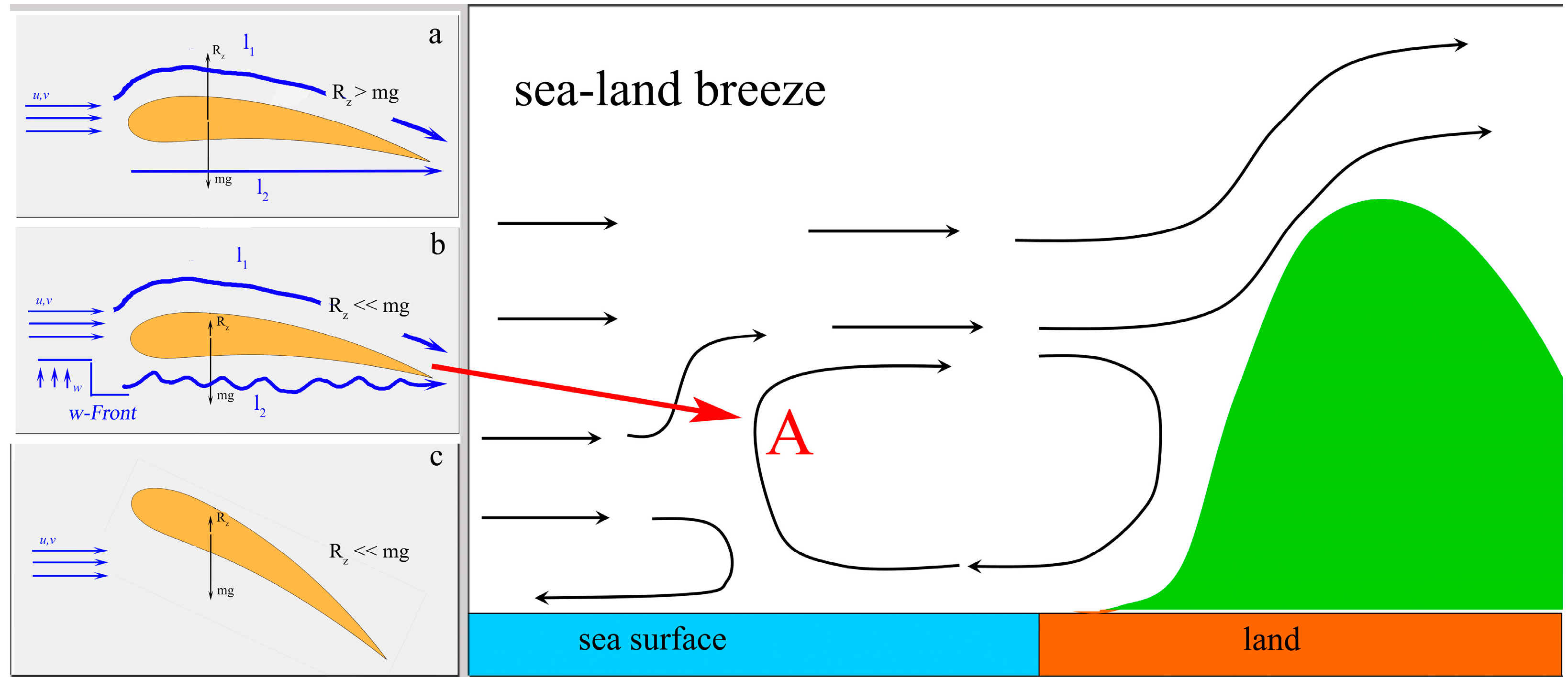
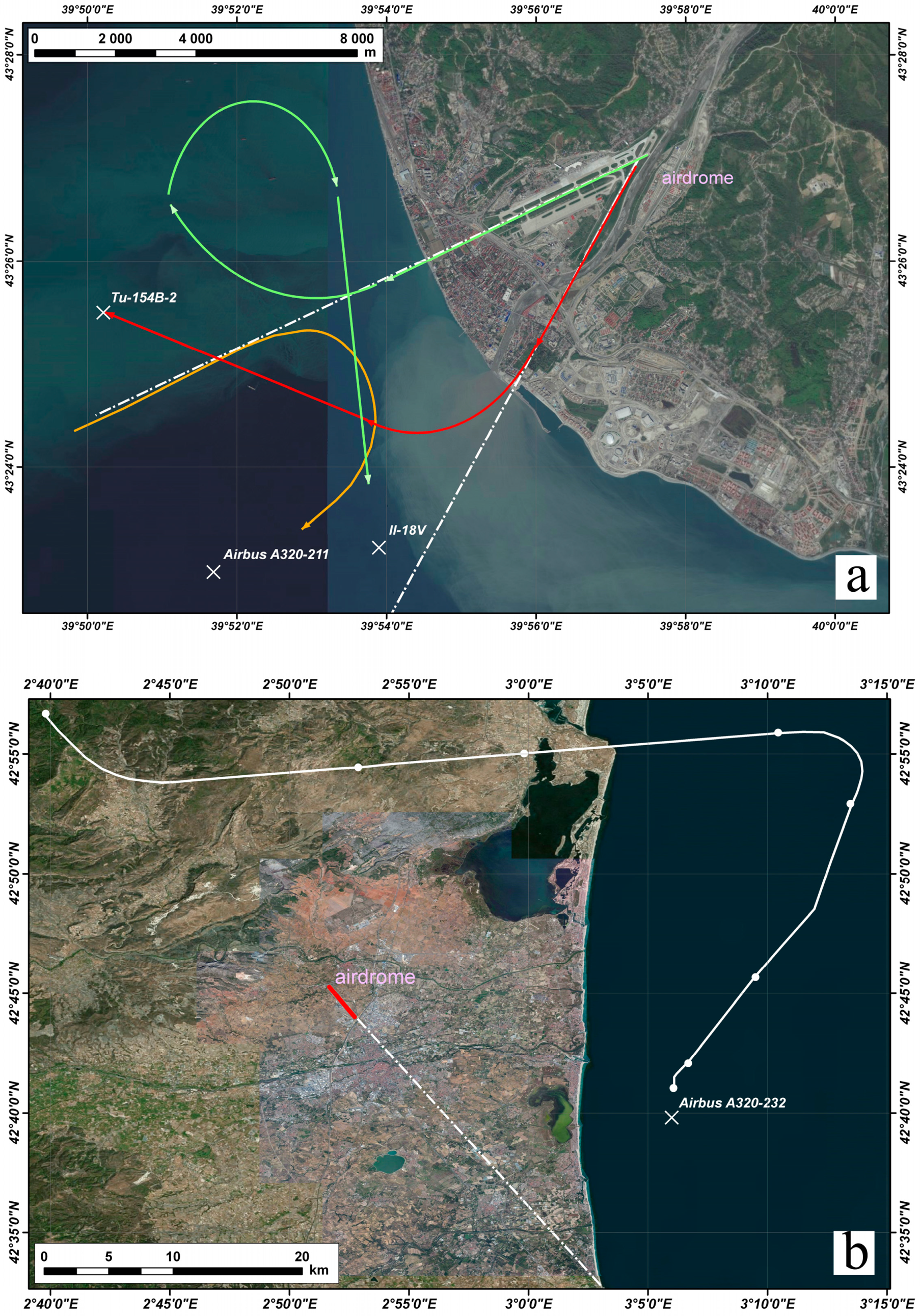
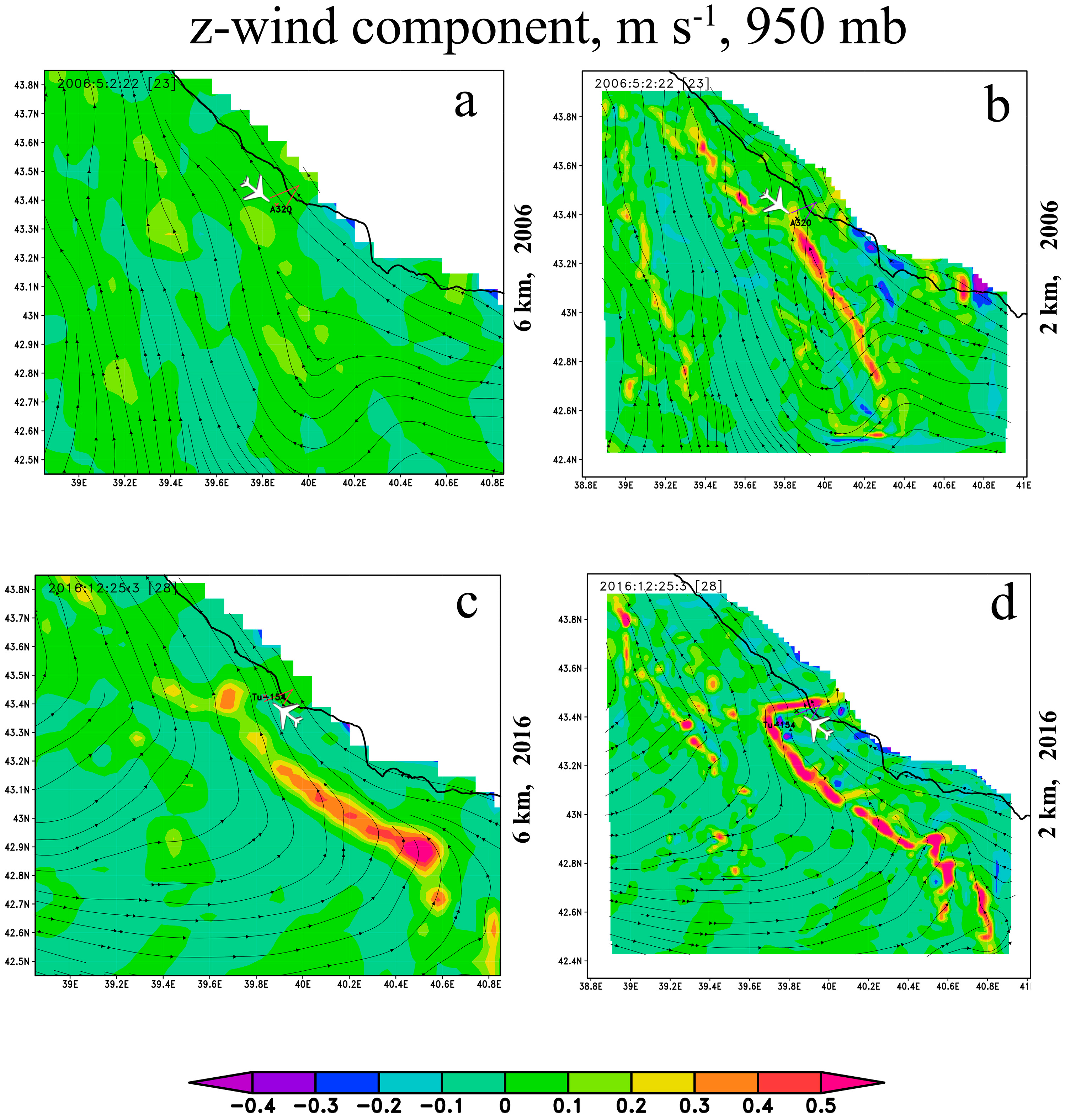
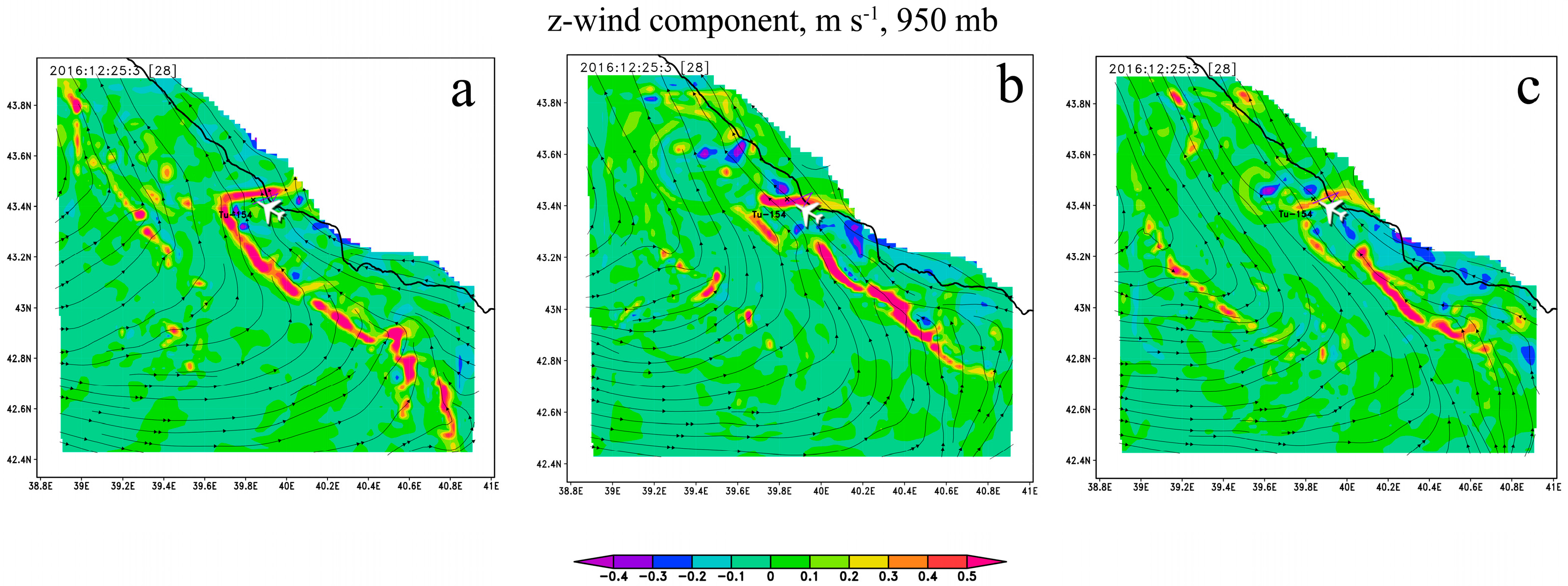
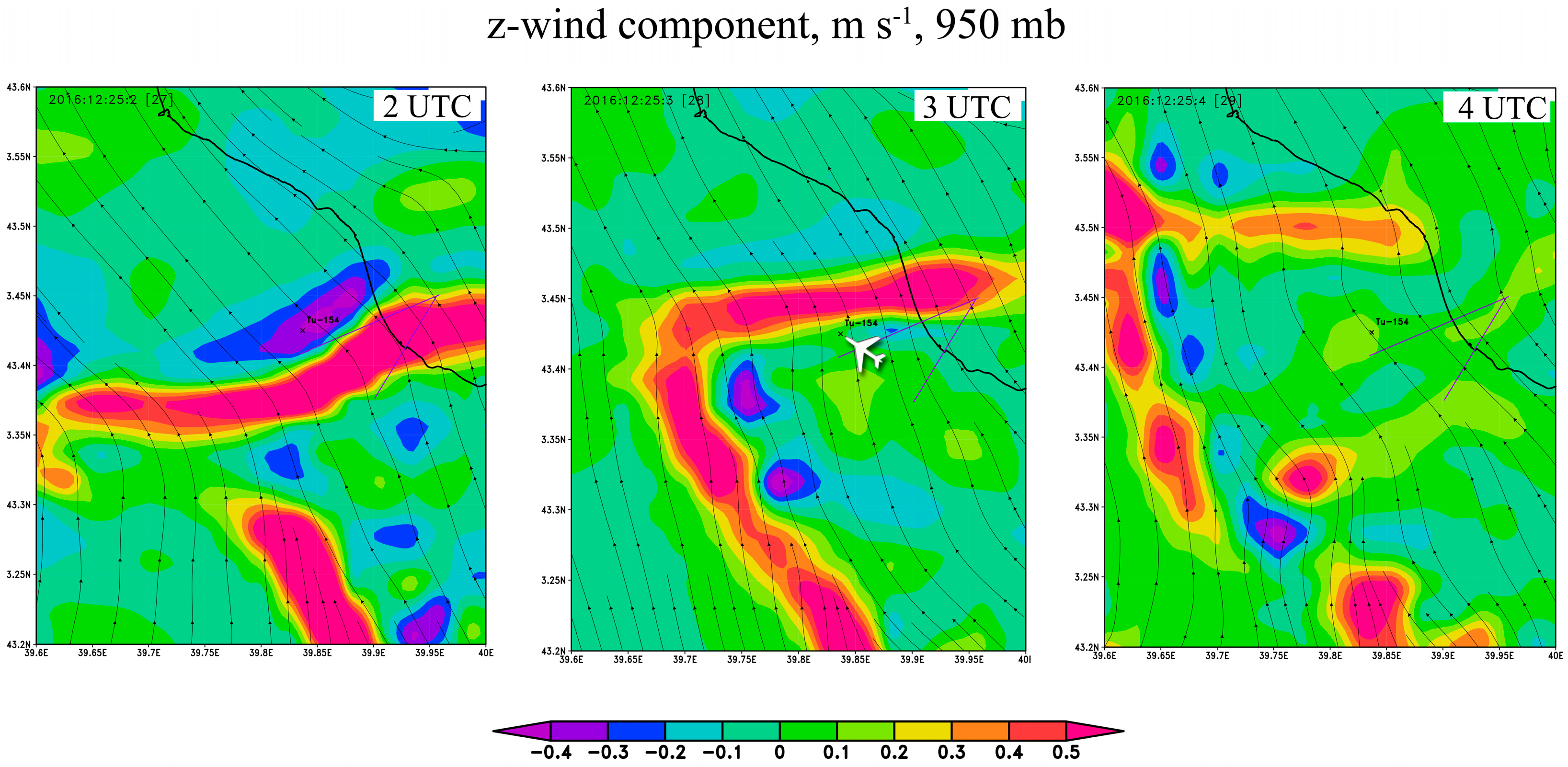

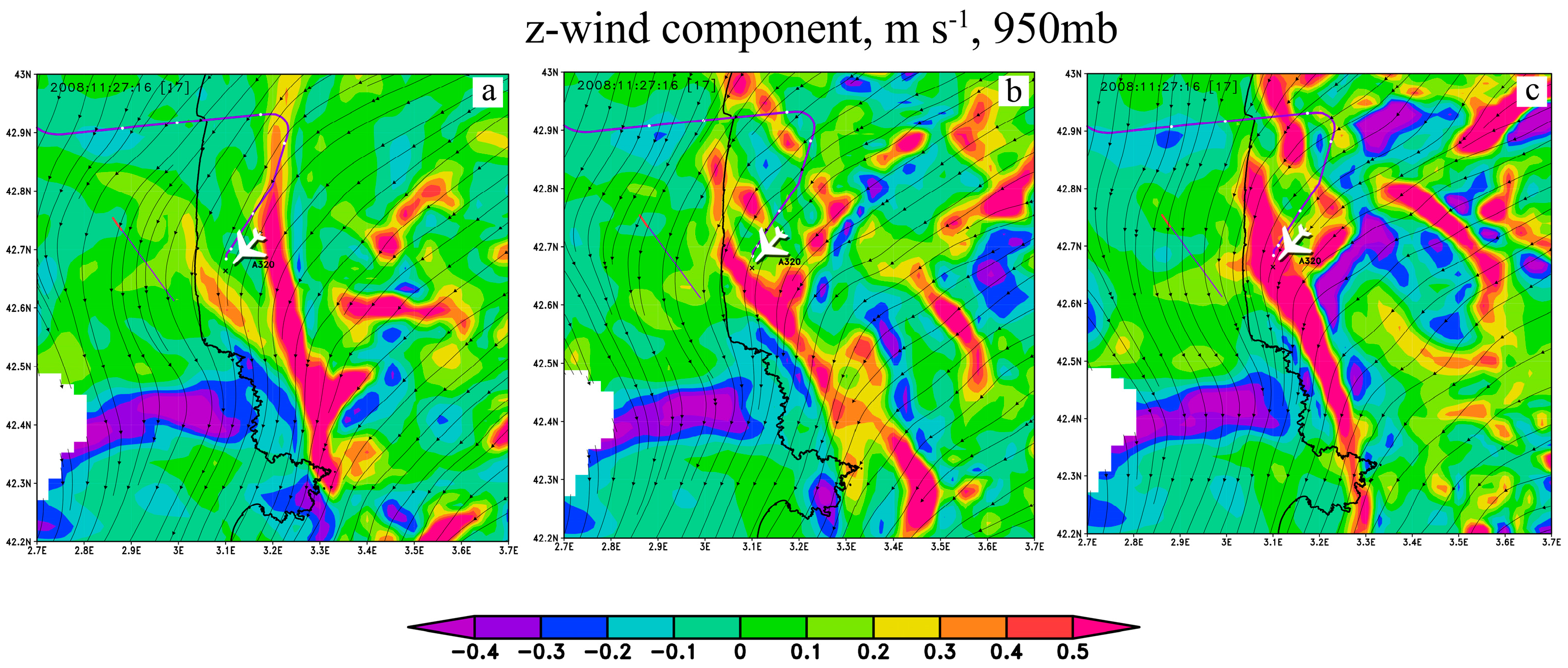
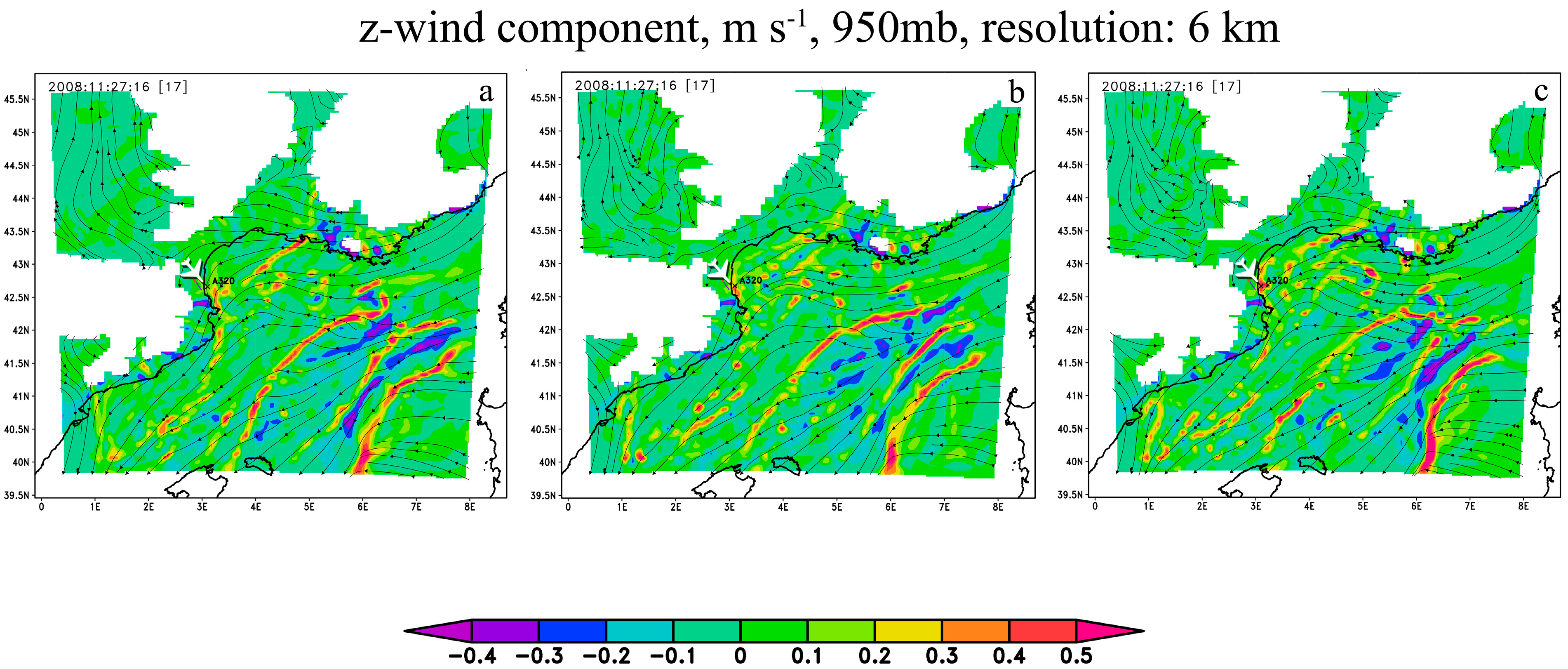
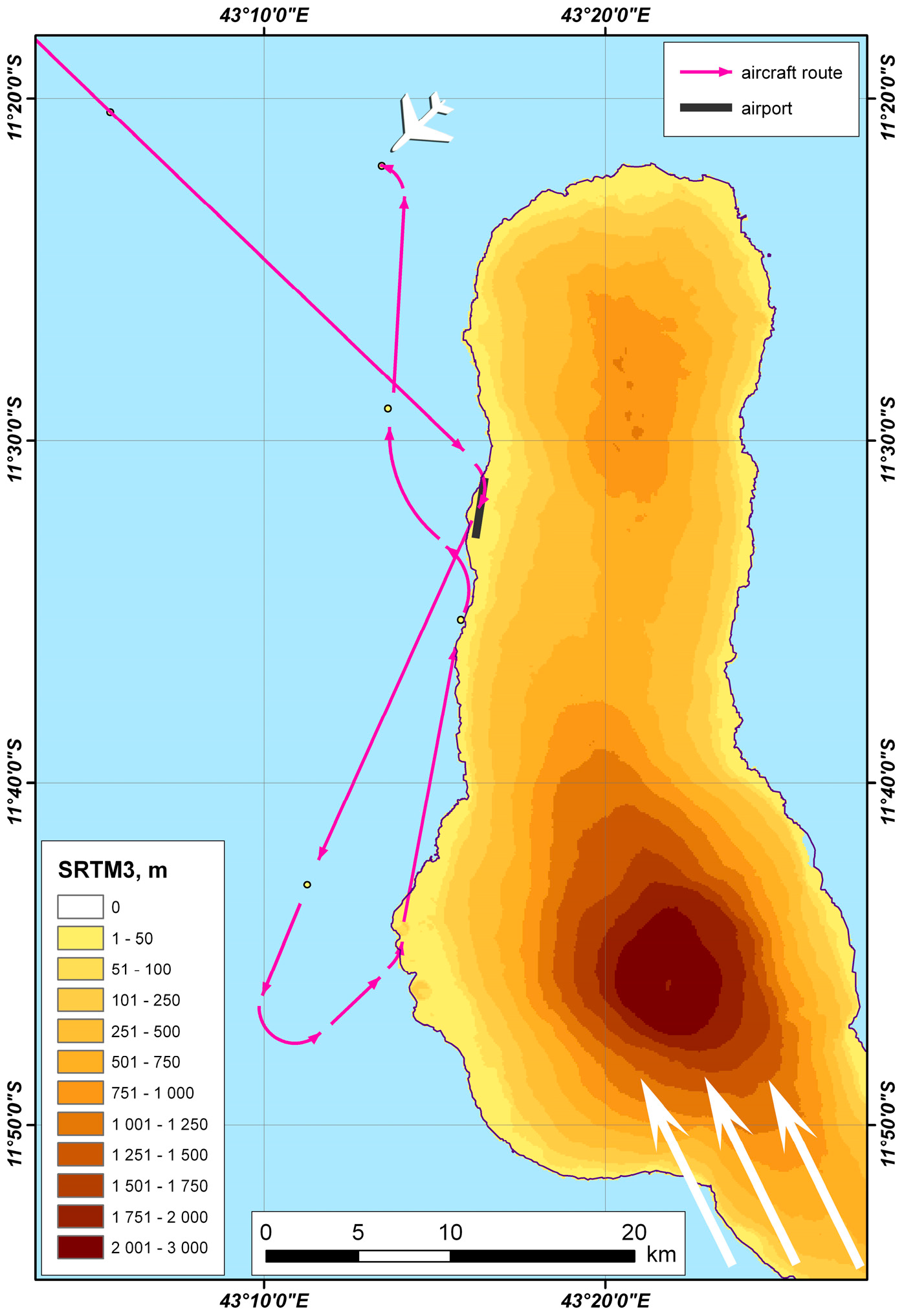
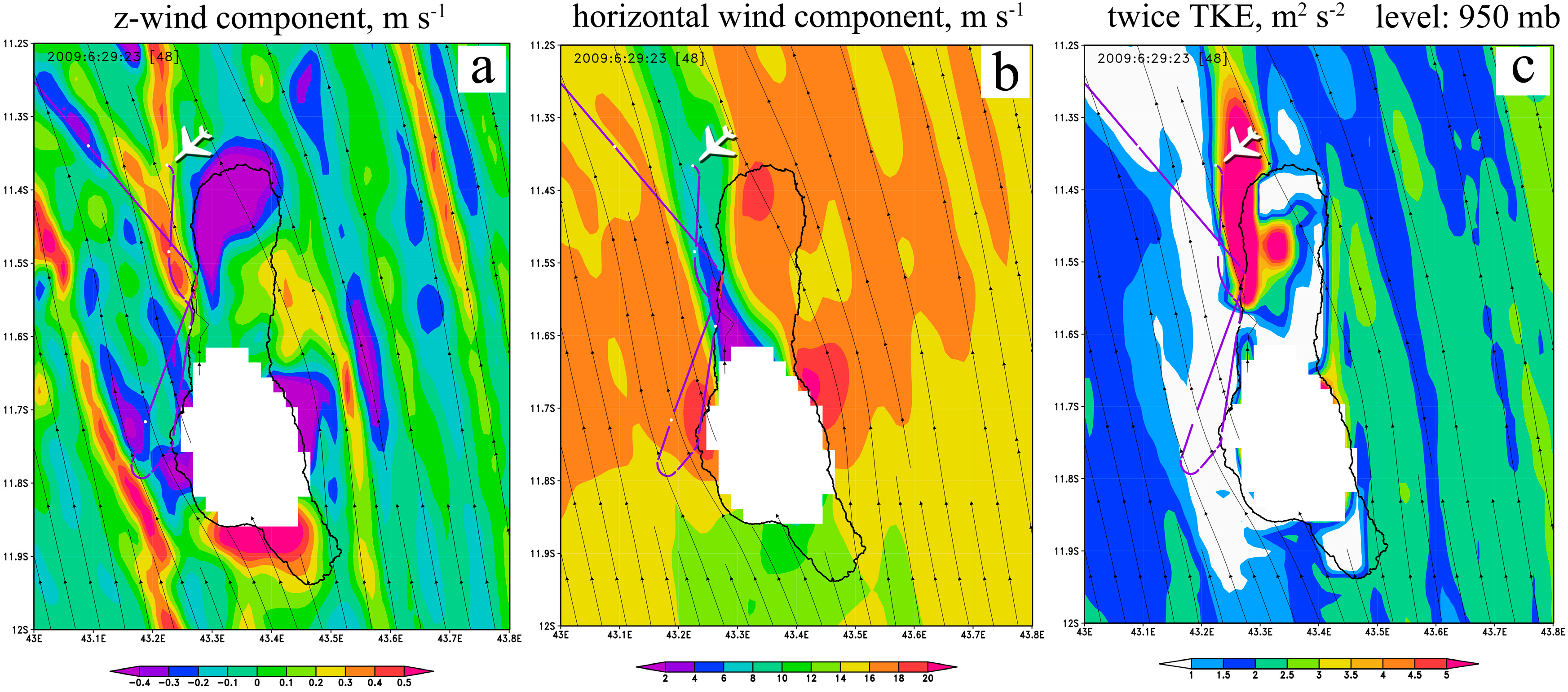
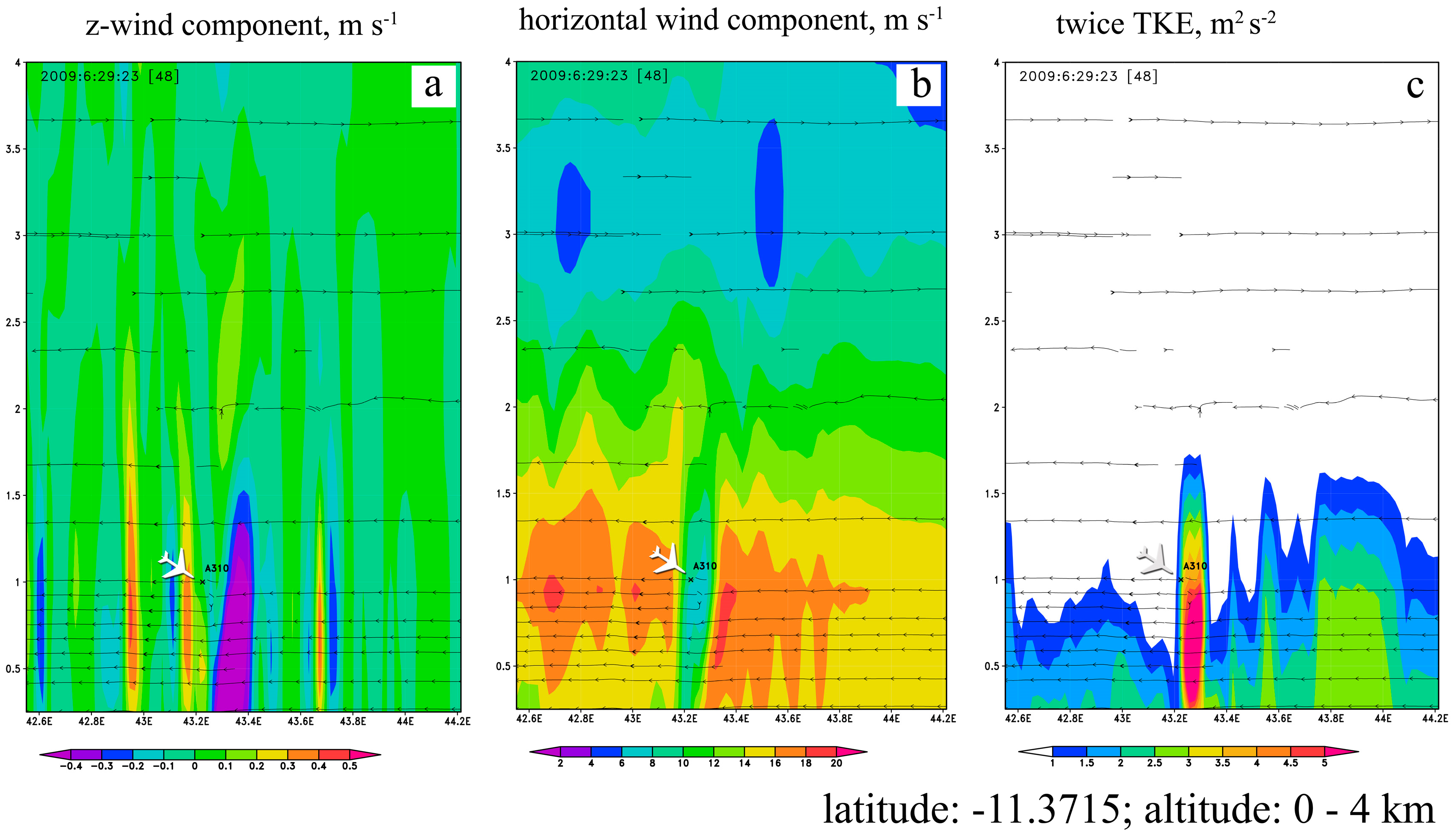
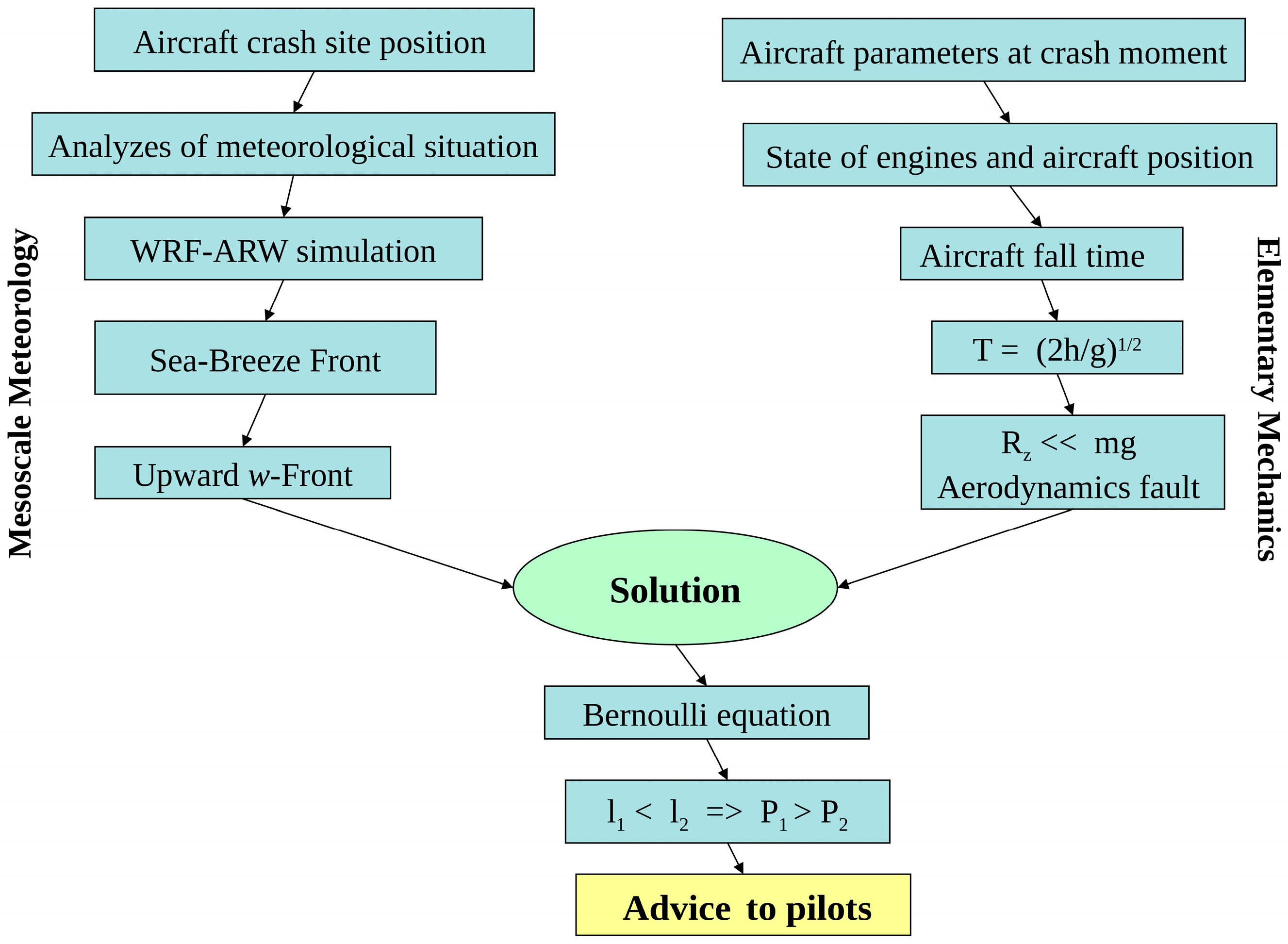
| Aircraft | Reg. Number | Crash Site | Date, UTC | Time, UTC | Latitude, ° | Longitude, ° | References | |
|---|---|---|---|---|---|---|---|---|
| 1 | Airbus A320-211 | ЕК-32009 | Adler/Sochi, Russia | 02.05.2006 | 22:13 | 43.383 | 39.8615 | [15,16] |
| 2 | Airbus A320-232 | 888T-XL | Perpignan, France | 27.11.2008 | 15:46 | 42.663 | 3.100 | [17,18] |
| 3 | Airbus A310-324 | 7O-ADJ | Comoros Islands | 29.06.2009 | 22:53 | −11.316 | 43.3269 | [19] |
| 4 | Tu-154 B-2 | RA-85572 | Adler/Sochi, Russia | 25.12.2016 | 02:27 | 43.425 | 39.837 | [15] |
| Model Parameter | Scheme, (Main Features) | Author Names and Reference | |
|---|---|---|---|
| Cumulus parameterization | Grell 3D scheme, improved version of Grell-Devenyi scheme | Grell and Devenyi, [23] | |
| Surface layer | Revised MM5 Monin-Obukhov scheme. The thermal and moisture roughness lengths over ocean are gave by COARE-3 formula (Fairall et al. 2003) | Jimenez et al. [24] | |
| Boundary layer scheme | Mellor-Yamada Nakanishi and Niino Level 2.5 PBL scheme, which predicts sub-grid TKE terms. Other MYNN options such as icloud_bl, bl_mynn_cloudmix, bl_mynn_mixlength and bl_mynn_cloudpdf are by default. | Nakanishi and Niino, [25] | |
| Land-surface model | (a) | no surface temp and moisture prediction | |
| (b) | 5-layers thermal diffusion scheme. Only soil temperature involved in this scheme. | ||
| (c) | 2-layers Pleim-Xiu scheme | Pleim and Xiu, [26,27] | |
| Shortwave radiation | Simple downward integration allowing efficiently for clouds and clear-sky absorption and scattering | Dudhia, [28] | |
| Longwave radiation | RRTM (Long-wave correlated-k 16 bands with cloud optical depth) | Mlawer et al. [29] | |
| Microphysics | WRF Double-Moment 6-class scheme | Lim and Hong, [30] | |
| Advection scheme | RK3 scheme | Wicker and Skamarock, [20,31] | |
| Subgrid horizontal mixing | horizontal deformation | Smagorinsky, [32] | |
| Aircraft | Reg. Number | Atmospheric Forcing | ||
|---|---|---|---|---|
| Sea-Land Front 1 | Turbulent Effect 2 | Topography Effect | ||
| Airbus A320-211 | ЕК-32009 | yes | ||
| Airbus A320-232 | 888T-XL | yes | possible | |
| Airbus A310-324 | 7O-ADJ | possible | yes | yes |
| Tu-154 B-2 | RA-85572 | yes | ||
© 2019 by the author. Licensee MDPI, Basel, Switzerland. This article is an open access article distributed under the terms and conditions of the Creative Commons Attribution (CC BY) license (http://creativecommons.org/licenses/by/4.0/).
Share and Cite
Safronov, A.N. Aviation Meteorology at Several Plane Crash Sites. Atmosphere 2019, 10, 50. https://doi.org/10.3390/atmos10020050
Safronov AN. Aviation Meteorology at Several Plane Crash Sites. Atmosphere. 2019; 10(2):50. https://doi.org/10.3390/atmos10020050
Chicago/Turabian StyleSafronov, Alexander N. 2019. "Aviation Meteorology at Several Plane Crash Sites" Atmosphere 10, no. 2: 50. https://doi.org/10.3390/atmos10020050
APA StyleSafronov, A. N. (2019). Aviation Meteorology at Several Plane Crash Sites. Atmosphere, 10(2), 50. https://doi.org/10.3390/atmos10020050





